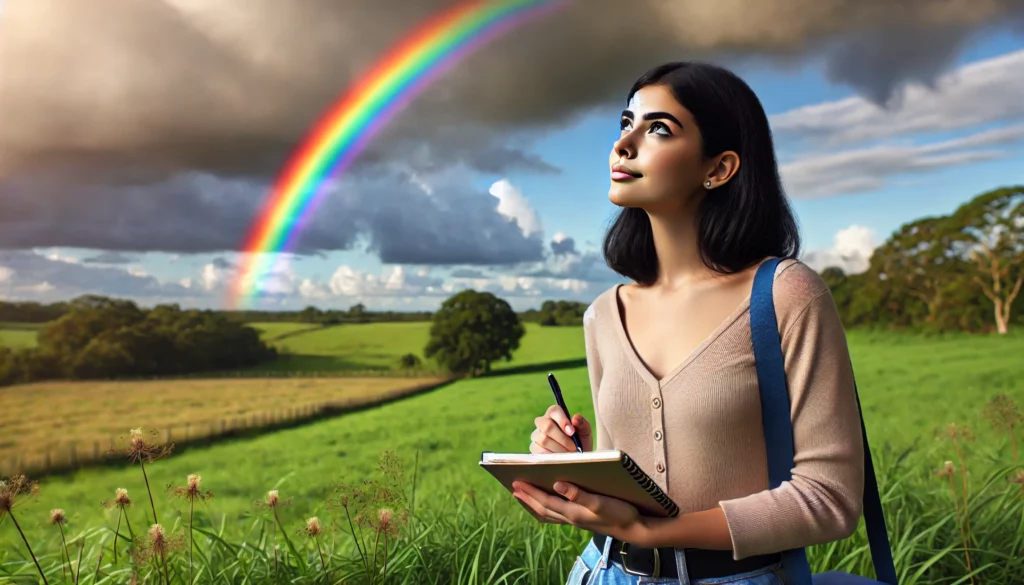An arc it’s the shape of a rainbow. But, have you ever gazed at a rainbow and wondered, what’s the shape of a rainbow? Sure, we all see that beautiful arc of colors, gracefully sweeping across the sky. But is that all there is to it, or are we missing something magical? Today, we’ll dive into the optical sorcery behind this breathtaking natural phenomenon and why rainbows sometimes hide their full, perfect circle from our curious eyes.
A classic arc
First off, let’s talk about that classic arc. Why, you ask, does a rainbow form this semi-circular shape in the sky? It’s all about the interaction between sunlight and water droplets. When sunlight enters a raindrop, it bends or refracts, then reflects off the inside surface of the drop, and finally bends again as it exits. During this dazzling dance of light, the various wavelengths (colors) separate out to create a rainbow. But here’s the twist: rainbows are actually full circles! Yes, you read that right. We only see a half-circle from the ground because the Earth’s horizon blocks the bottom half. If you’ve ever been on a tall building or—better yet—an airplane, you might have caught a glimpse of a full circular rainbow below you. Isn’t it a bit frustrating that the ground gets in the way of our rainbow treasure hunt?
Find the treasure
Speaking of treasure, it’s no wonder myths sprung up about a pot of gold at the end of the rainbow. After all, our perspective from the ground makes it look like the rainbow arcs down to touch some faraway field or hilltop. But when you start thinking about the question, what’s the shape of a rainbow, it becomes clear why hunting for the end of it is an exercise in futility. Even if you ran toward where you thought the rainbow landed, it would just keep moving farther away. That’s Mother Nature’s way of having a laugh at our expense. Those clever leprechauns, right?
An illusion of light and perspective
Now, let’s expand on that idea of a full circle rainbow. It’s not just something pilots and skydivers get to marvel at; it’s a reminder that rainbows are an illusion of light and perspective. To see a complete circle, you need to be high enough with the sun positioned just right behind you. Imagine yourself floating above a giant ring of colors. Cool, huh? Unfortunately, even in a plane, you won’t find a pot of gold—or an end, for that matter. That’s because rainbows don’t really “end”; they exist at a specific angle relative to the observer. So the shape of a rainbow isn’t just an arc—it’s an unbroken loop that leaves us dreaming.
42 degrees of color
Let’s get technical for a moment. The light angle for a rainbow is usually about 42 degrees. This is why rainbows are always the same basic shape, whether you’re in Ireland or Indiana. The colors—red on the outside and violet on the inside—are not random. Each raindrop only reflects one color back to your eyes, depending on its height and angle. It’s a marvel of physics that seems almost too perfectly orchestrated. But hey, if nature loves symmetry, who are we to argue?
Ultimately, the question what’s the shape of a rainbow circles (pun intended) back to the idea that our perspective shapes what we see. It’s a bit poetic, don’t you think? Rainbows, with all their fleeting beauty, remind us of the limits of our perception. They’re there to dazzle us, not to be captured or conquered. So, if you’re ever tempted to chase that rainbow, remember: the real treasure is in understanding the science—and maybe telling a good story about your quest.
In the end, while a leprechaun’s pot of gold might be forever out of reach, the joy of understanding how rainbows form is its own reward. And who knows? Maybe the next time you ask yourself, what’s the shape of a rainbow, you’ll smile and keep chasing that circle of light, if only for the wonder of it.

